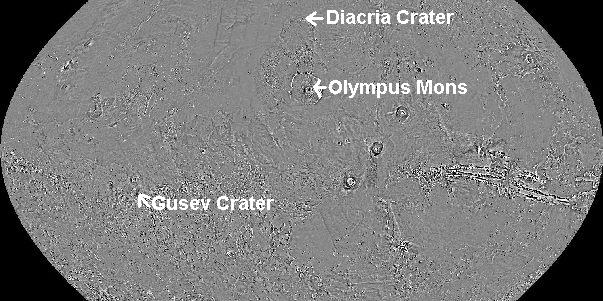Landing Site
Targeting Diacria
Selection Process
Step-by-Step Results
Top Six Sites
Previous Landings
Site Terminology
Sources
Landing Site
Landing Site Selection
Our landing site is Diacria Southwest, at 39.5°N, 135.5°W. It includes a crater, almost certainly filled with fluvial sediment. In places it also has steep rim walls, which can be used by the cliffhanger to sample stratigraphic levels down to the crater floor.
The landing site lies in the vicinity of Olympus Mons. There may be ancient geothermal features here as a result. The elevation of the site is between 0km and 1km below average surface elevation.

Viking Orbiter composite from Planetary Data System Imaging Node, NASA
The landing ellipse is small, based on our best estimates about the accuracy of a piloted landing with modern equipment, software, and techniques. From east to west, the ellipse runs 30km in length. From north to south, the ellipse is 20km wide. Landing anywhere inside the ellipse will ensure access to all major points of interest at this site, and will ensure safe landing, away from crater rims, water channels, and boulder fields.

Photo compliments of Planetary Data System Imaging Node, NASA. Ellipse is an addition to the original NASA photo composite.
More images of the landing site are available on our targeting page.
This site was selected from 150 candidates. See how we picked this one.
Our backup site, visible in Image 1, above, is Gusev Crater. This site is very similar to the Diacria site, but it is much larger. The mission would land here only if the Diacria Crater site were found to be unacceptably rocky, which can be determined visually at close range.

Photo compliments of Planetary Data System Imaging Node, NASA